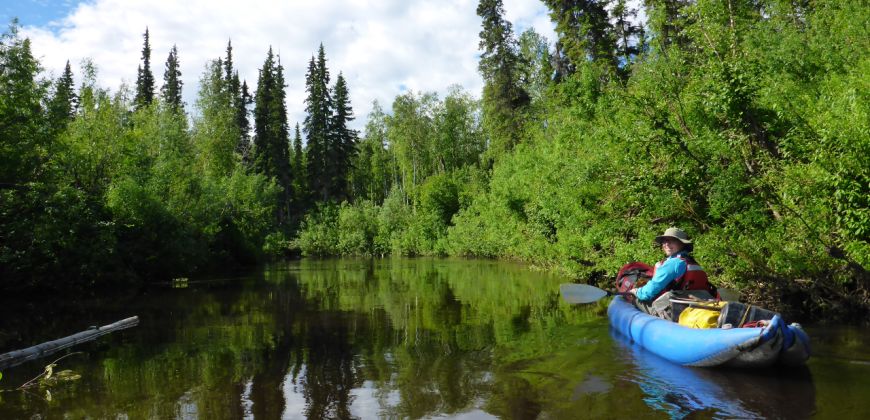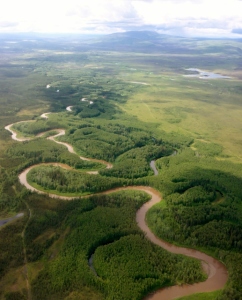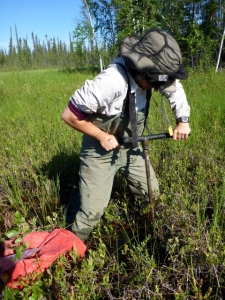
CSU student wins national grants

Successfully navigating stretches of the longest river in Alaska in a kayak ladened with soil samples and gear was only one of many great achievements by CSU graduate student Katherine Lininger this year.
After a field season of research in Alaska’s wilderness, Lininger found out that she had been awarded the prestigious Horton Research Grant from the American Geophysical Union (AGU) Hydrology section. The $10,000 grant came as a surprise to the humble yet diligent student who plans to use the money to fund her next season of research in Alaska. The award comes on the heels of her also being selected for two other awards: the Morisawa Award for student research from the Geological Society of America’s Quaternary Geology and Geomorphology division and the Wolman Research Grant from the Association of American Geographers’ Geomorphology specialty group.
“I feel so fortunate to have been selected for these competitive grants,” said Lininger.
Lininger is a National Science Foundation Graduate Research Fellowship recipient and came to Colorado State University to pursue her Ph.D. in fluvial geomorphology in the Warner College of Natural Resources. CSU’s Department of Geosciences is ranked among the top programs in the nation for earth sciences. While Lininger was recruited by other universities, she chose CSU in part because of the opportunity to work with renowned geomorphologist Ellen Wohl and because of research support opportunities made possible by donors.
“Having access to the additional support of research assistantships and grants at CSU was a big factor in my decision,” Lininger said. “Every bit of support really helps, especially when you’re working in remote locations that are expensive to travel to.”
Hunting carbon clues in the last frontier

Lininger floated more than 180 miles of river in the rugged and remote terrain of central Alaska to better understand river-floodplain systems. She spent five weeks in the Yukon Flats National Wildlife Refuge to study how much carbon is stored in subarctic floodplain ecosystems.
Quantifying carbon storage in the Yukon Basin floodplains can help scientists understand the carbon cycle and how carbon moves between the land, ocean, and atmosphere. Lininger and her colleagues collected floodplain soil samples to determine the organic carbon content of the active layer, which is the top-most part of the soil that thaws out in the summer. Knowing how much carbon is stored in the active layer could also give clues about how much carbon is in the permafrost beneath, which is continuously frozen soil. Melting permafrost due to climate change could release stored carbon into the atmosphere.
Yukon Flats Aquatic Ecologist Joshua Rose, a CSU alumnus and former student of Wohl’s, reached out to Wohl to organize the collaborative research in the 8.6-million acre refuge. Not much is known about the properties of the expansive floodplain system, especially because hydrologic data collected in the lower 48 don’t always apply to Alaska.
“The floods in the continental U.S. are driven by snowmelt, whereas Alaskan floods are driven by ice melt and ice jams,” said Rose.
The research conducted by Lininger, Wohl, and Rose will not only inform carbon studies but will also generate much-needed information about the physical characteristics of river systems in an under-studied region of Alaska.
Learning from a leader in the ‘field’

Lininger couldn’t have chosen a more challenging site for her PhD research. The remote location is only accessible by a 150 mile trip by boat, plane or helicopter and is inhabited by swarming mosquitos and bears. The days were mentally and physically challenging, including hiking and paddling sometimes until midnight before finding a suitable place to camp.
“Field work in such a remote location can be difficult, but it feels good to complete it successfully,” Lininger said. “Ellen is very encouraging though, and she’s a tough field scientist.”
Wohl played a big role in helping Lininger with her first field season for her PhD research, both in establishing the collaboration with the Refuge and accompanying Lininger in Alaska to study the site.
“I had heard of Ellen prior to coming to CSU and was excited to work with a prominent female scientist and a role model,” Lininger said. “Ellen has an amazing reputation for her work as a scientist and her ability to train graduate students for successful careers.”
Wohl has been a professor at CSU’s Department of Geosciences for 24 years, and is a leader in the geosciences field for her research on sediment transport, wood dynamics and the role of floods in shaping channel morphology. She is an AGU Fellow and is responsible for advancing the understanding of geomorphology, evolution and restoration of mountains, and the roles of bedrock and topical rivers.
Future research collaboration
Lininger, Wohl, and Rose are hoping the current research will be just the beginning of a series of collaborative projects to better understand how large subarctic rivers function and impact the broader ecosystem.
“It is wonderful to collaborate with CSU on this research, and there is plenty of work to be done to understand the importance of this vast system and how it might be changing,” said Rose.
Click here to read more about Lininger’s field experience featured in National Geographic.